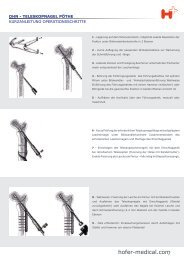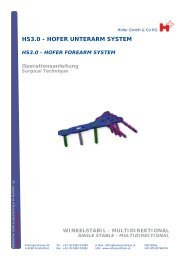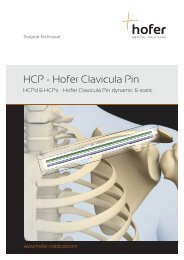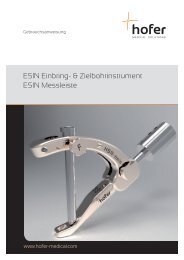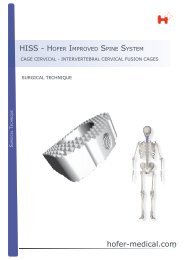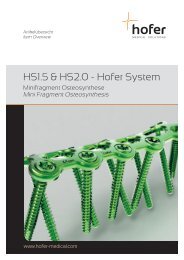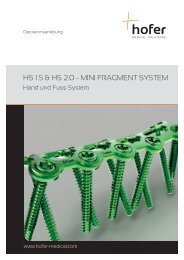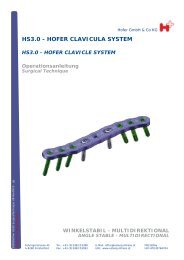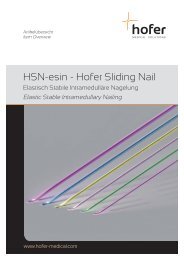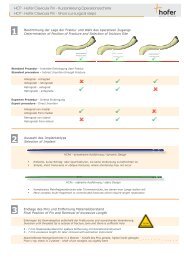20090507wr HS30 SurgicalTechnique UA Rev04V0 ... - Hofer-medical
20090507wr HS30 SurgicalTechnique UA Rev04V0 ... - Hofer-medical
20090507wr HS30 SurgicalTechnique UA Rev04V0 ... - Hofer-medical
Erfolgreiche ePaper selbst erstellen
Machen Sie aus Ihren PDF Publikationen ein blätterbares Flipbook mit unserer einzigartigen Google optimierten e-Paper Software.
HS3.0 - HOFER OBERARM SYSTEM<br />
HS3.0 - HOFER UPPER ARM SYSTEM<br />
<strong>Hofer</strong> GmbH & Co KG<br />
Operationsanleitung<br />
Surgical Technique<br />
<strong>20090507wr</strong> <strong>HS30</strong> <strong>SurgicalTechnique</strong> <strong>UA</strong> <strong>Rev04V0</strong> - ge<br />
Subject to Modifications<br />
Fehringerstrasse 45<br />
A-8280 Fürstenfeld<br />
WINKELSTABIL - MULTIDIREKTIONAL<br />
ANGLE STABLE - MULTIDIRECTIONAL<br />
Tel.: +43 (0)3382/53388<br />
Fax: +43 (0)3382/53093<br />
E-Mail: office@osteosynthese.at<br />
URL: www.osteosynthese.at<br />
FN21826y<br />
UID ATU30764704
Inhalt<br />
Content<br />
Vorwort<br />
Preface<br />
Verwendungszweck<br />
Purpose<br />
Implantat spezifische Informationen<br />
Implant Specific Information<br />
SF-ST-1<br />
SF-ST-2<br />
<strong>UA</strong>-ST-3<br />
Indikationen und Kontraindikationen<br />
Indications and Contra Indications<br />
Patientenlagerung<br />
Position of Patient<br />
Zugänge<br />
Approaches<br />
Operationstechnik<br />
Operation Technique<br />
SF-ST-4<br />
#1 - Platzierung des Implantes<br />
Insertion of the Implant<br />
#2 - Temporäre Fixierung<br />
Temporary Fixation<br />
#3 - Ausrichtung des Implantates<br />
Orienting the Implant<br />
#4 - Schraubenplatzierung<br />
Screw Placement<br />
#5 - Entfernung der temporären Fixierung oder Instrumente<br />
Removal of temporary Fixations or Instruments<br />
#6 - Wundverschluss<br />
Wound Closure<br />
#7 - Postoperative Behandlung<br />
Post Operative Treatment<br />
#8 - Implantatentfernung<br />
Implant-Removal<br />
Klinische Fälle<br />
Clinical Cases<br />
<strong>UA</strong>-ST-5
Vorwort<br />
Preface<br />
Dieses Dokument enthält Informationen zur Anwendung<br />
von <strong>Hofer</strong> Implantaten und Instrumenten.<br />
This document provides information about the handling of<br />
<strong>Hofer</strong> implants and instruments.<br />
Diese Anleitung soll als eine Ergänzung und unter keinen<br />
Umständen als Ersatz zu bestehender Literatur über Operationsmethoden<br />
der Orthopädie und Traumatologie betrachtet<br />
werden.<br />
This operation manual‘s intention shall be considered as<br />
an addition and under no circumstances as a substitute<br />
to existing literature about surgical methods within traumatolgy.<br />
Dieser Inhalt soll als eine Empfehlung für eine standardisierte<br />
Vorgehensweise in der Anwendung der Produkte<br />
verstanden werden, ohne auf weitergehende erforderliche<br />
Maßnahmen, Zusatzeingriffe und mögliche Erweiterungen<br />
der OP-Technik einzugehen.<br />
Die tatsächliche Auswahl des erforderlichen bzw. geeigneten<br />
Implantates sowie der Implantationsmethode muß<br />
durch den Chirurgen aufgrund seiner Fachkenntnisse und<br />
anhand der individuelle Befundkonstellation erfolgen.<br />
The content shall be regarded as a recommendation for a<br />
standardized procedure of how to apply the products without<br />
addressing the issues of any further necessary tasks,<br />
addtional operative actions and possible extensions of the<br />
surgical technique.<br />
The actual selection of the most suitable implant and its<br />
implantation method has to happen exclusively by the surgeon<br />
based on his education and the individual diagnostic<br />
findings.<br />
Die Abbildungen innerhalb dieses Dokumentes sollen exemplarisch<br />
die Operationsanleitung bildlich unterstützen.<br />
Abweichungen zu diesen Darstellungen können auftreten.<br />
Please also consider that all illustrations printed here have<br />
a purely symbolic character to support the description of<br />
the surgical technique and can vary<br />
Diese Operationsanleitung enthält keine Angaben über<br />
die richtige Handhabung des Instrumentariums. Entsprechende<br />
Unterlagen sind verfügbar in Form von<br />
• Gebrauchsanweisung für Instrumente: Intra- & Postoperative<br />
Handhabung<br />
• Gebrauchsanweisung für Implantate (ist jedem Implantat<br />
beiliegend)<br />
Bitte nehmen Sie zur Kenntnis, dass die Diagnosestellung<br />
sowie Festlegung der Behandlungsstragie einzig beim Chirurgen<br />
liegt.<br />
Eine adäquate Reposition der Fraktur muss stets angestrebt<br />
werden!<br />
Furthermore these operation instructions don‘t contain any<br />
details on the use of the instruments. Corresponding documents<br />
are available as indicated within the section „General<br />
Instructions“.<br />
These are namely:<br />
• Instruction manual for instruments: Intra and post operative<br />
handling<br />
• Instruction manual for implants (enclosed to each implant)<br />
Note that it is in the surgeons function to identify and characterize<br />
the respective injury and its subsequent treatment.<br />
An adequate reduction of the anatomical structures has to<br />
be established always!<br />
20080215wr <strong>HS30</strong> <strong>SurgicalTechnique</strong> Preface Rev03V0 - ge<br />
SF-ST-1
Verwendungszweck<br />
Purpose<br />
Das HS3.0 System der <strong>Hofer</strong> Gmbh & Co KG (HOFER) ist<br />
ein multidirektionales und winkelstabiles Kleinfragment<br />
Implantatesystem basierend auf dem Fixateur intere Prinzip.<br />
Das HS3.0 System dient zur Behandlung von epiphysären,<br />
metaphysären und intraartikulären Frakturen kleiner Knochen.<br />
Alle HOFER Produkte resultieren aus einer gemeinsamen<br />
Entwicklung bestehend aus erfahrenen Anwendern und<br />
unseren Ingenieuren. Diese erfolgreiche Kooperation führt<br />
zu Produkten, die die anatomischen und funktionelle Anforderungen<br />
der jeweiligen Struktur aufgrund des anatomisch<br />
vorgeformten Low-Profil Designs sowie der vielfältigen<br />
Versorgungsmöglichkeiten von einfachen bis Trümmerfrakturen<br />
erfüllen.<br />
Weiterführendere Informationen zu den technischen Möglichkeiten<br />
dieses Implantatesystems enthält die Broschüre<br />
„Tips & Tricks“.<br />
The HS3.0 <strong>Hofer</strong> System is a multi directional and angle<br />
stable implant system for small fragments based on the<br />
internal fixateur principle.<br />
The HS3.0 system is designed to meet epiphyseal, metaphyseal<br />
and intra articular fractures of small bones only.<br />
All <strong>Hofer</strong> products result out of a joint development of<br />
experienced clinicians and our engineers. This successful<br />
cooperation results in providing products to meet the anatomical<br />
and functional requirements of the respective sites<br />
due to their pre-contoured and low profile design and to<br />
provide an almost unrestricted operative treatment ranging<br />
from simple to cominuted fractures.<br />
For more indepth information on the technical capabilities<br />
of this implant system we would like to recommend the<br />
additionally available brochure „Tips & Tricks“.<br />
20080215wr <strong>HS30</strong> <strong>SurgicalTechnique</strong> Purpose Rev02V0 - ge<br />
SF-ST-2
Implantat spezifische Informationen<br />
Implant Specific Information<br />
HHS - Humerus Platte proximal ws wv<br />
HHS - Humerus Plate proximal as av<br />
Indikationen<br />
Alle subkapitalen Humeruskopffrakturen und die<br />
meisten Oberarmkopffrakturen<br />
Indications<br />
All subcapitale humeral head fractures and<br />
most other humeral head fractures<br />
Kompatibel zu HS3.0 Knochenschrauben<br />
Bohrergrößen für<br />
Spngiosaschrauben 2,0 mm<br />
Kortikalisschrauben 2,5 mm<br />
Compatible to HS3.0 Bone Screws<br />
Drill Bit Sizes for<br />
Cancellous Screw 2,0 mm<br />
Cortical Screw 2,5 mm<br />
Patientenlagerung und Zugänge<br />
Patientenlagerung:<br />
Standard<br />
Zugang:<br />
Standard<br />
Patient Positioning and Standard Approach<br />
Patient Positioning:<br />
Standard<br />
Approach:<br />
Standard<br />
Plattenspezifische Details<br />
- 14 Schraubenplatzierungsmöglichkeiten für<br />
die Epiphyse<br />
- Befestigungsmöglichkeit für das Tuberkulumfragment<br />
- Kirschnerdraht Bohrungen zur temporären<br />
Fixierung oder Frakturreposition<br />
- Langloch zur primären Fixierung und Plattenausrichtung<br />
- Alle Bohrung passend für winkelstabile und<br />
nicht winkelstabile Schrauben<br />
- Vorgebogen, Nachbiegen möglich, auch im<br />
Lochbereich<br />
- Low-profile Design, minimaler Schraubenkopfüberstand<br />
- Winkelvariabilität und Winkelstabilität erlauben<br />
ein weiter distales Platzieren der Platte<br />
- Schrauben frei divergierend oder kreuzend<br />
platzierbar für Erhaltung der Kopfrekonstruktion<br />
Plate specific Details<br />
- 14 screw placement options for the epiphysial<br />
region<br />
- Suture holes for tuberculi fragment fixation<br />
- K-Wire holes for temporary fixation and / or<br />
fracture reduction<br />
- Slotted hole for primary fixation and plate<br />
orientation<br />
- All holes accept angle stable or not angle<br />
stable screws<br />
- Pre Shaped, re-contouring possible, even<br />
across holes<br />
- Low-profile design, minimal screw head<br />
protrusion<br />
- Angular variability and stability allows a further<br />
distal location of the plate<br />
- Screws can be placed in a diverging or<br />
crossing manner for maintaing the restored<br />
humeral head<br />
HHSdu - Humerus Platte distal ulnare Säule ws wv<br />
Humerus Plate distal ulna Column as av<br />
Indikationen<br />
Extra & intraartikuläre Frakturen des distalen<br />
Humerus<br />
Indications<br />
Extra & intra-articular fractures of the distal<br />
humerus<br />
Kompatibel zu HS3.0 Knochenschrauben<br />
Bohrergrößen für<br />
Spngiosaschrauben 2,0 mm<br />
Kortikalisschrauben 2,5 mm<br />
Compatible to HS3.0 Bone Screws<br />
Drill Bit Sizes for<br />
Cancellous Screw 2,0 mm<br />
Cortical Screw 2,5 mm<br />
Patientenlagerung und Zugänge<br />
Patientenlagerung:<br />
Standard<br />
Zugang:<br />
Standard<br />
Patient Positioning and Standard Approach<br />
Patient Positioning:<br />
Standard<br />
Approach:<br />
Standard<br />
Plattenspezifische Details<br />
- 4 Schraubenplatzierungsmöglichkeiten für den<br />
epiphysären Bereich, 6 für den diaphysären<br />
- Alle Bohrung passend für winkelstabile und<br />
nicht winkelstabile Schrauben<br />
- Vorgebogen, Nachbiegen möglich, auch im<br />
Lochbereich<br />
- Low-profile Design, minimaler Schraubenkopfüberstand<br />
Plate specific Details<br />
- 4 screw placement options for the epiphysial<br />
region, 6 further ones for the shaft region<br />
- All holes accept angle stable or not angle<br />
stable screws<br />
- Pre Shaped, re-contouring possible, even<br />
across holes<br />
- Low-profile design, minimal screw head<br />
protrusion<br />
<strong>UA</strong>-ST-3.1
Implantat spezifische Informationen<br />
Implant Specific Information<br />
HHSdrd - Humerus Platte distal radiale Säule dorsal ws wv<br />
Humerus Plate distal radial Column dorsal as av<br />
Indikationen<br />
Extra & intraartikuläre Frakturen des distalen<br />
Humerus<br />
Indications<br />
Extra & intra-articular fractures of the distal<br />
humerus<br />
Kompatibel zu HS3.0 Knochenschrauben<br />
Bohrergrößen für<br />
Spngiosaschrauben 2,0 mm<br />
Kortikalisschrauben 2,5 mm<br />
Compatible to HS3.0 Bone Screws<br />
Drill Bit Sizes for<br />
Cancellous Screw 2,0 mm<br />
Cortical Screw 2,5 mm<br />
Patientenlagerung und Zugänge<br />
Patientenlagerung:<br />
Standard<br />
Zugang:<br />
Standard<br />
Plattenspezifische Details<br />
- 4 Schraubenplatzierungsmöglichkeiten für den<br />
epiphysären Bereich, 6 für den diaphysären<br />
- Alle Bohrung passend für winkelstabile und<br />
nicht winkelstabile Schrauben<br />
- Kompatibel zu der HHS-DFD Kopfschraube als<br />
Zugschraube<br />
- Vorgebogen, Nachbiegen möglich, auch im<br />
Lochbereich<br />
- Low-profile Design, minimaler Schraubenkopfüberstand<br />
- Erlaubt gleichzeitige Implantation der HHSdrl<br />
Patient Positioning and Standard Approach<br />
Patient Positioning:<br />
Standard<br />
Approach:<br />
Standard<br />
Plate specific Details<br />
- 4 screw placement options for the epiphysial<br />
region, 6 further ones for the shaft region<br />
- All holes accept angle stable or not angle<br />
stable screws<br />
- Compatibel to HHS-DFD head screw as lag<br />
screw<br />
- Pre Shaped, re-contouring possible, even<br />
across holes<br />
- Low-profile design, minimal screw head<br />
protrusion<br />
- HHSdrl plate can be implantated in addition<br />
without interferance<br />
HHSdrl - Humerus Platte distal radiale Säule lateral ws wv<br />
Humerus Plate distal radial Column lateral as av<br />
Indikationen<br />
Extra & intraartikuläre Frakturen des distalen<br />
Humerus<br />
Indications<br />
Extra & intra-articular fractures of the distal<br />
humerus<br />
Kompatibel zu HS3.0 Knochenschrauben<br />
Bohrergrößen für<br />
Spngiosaschrauben 2,0 mm<br />
Kortikalisschrauben 2,5 mm<br />
Compatible to HS3.0 Bone Screws<br />
Drill Bit Sizes for<br />
Cancellous Screw 2,0 mm<br />
Cortical Screw 2,5 mm<br />
Patientenlagerung und Zugänge<br />
Patientenlagerung:<br />
Standard<br />
Zugang:<br />
Standard<br />
Plattenspezifische Details<br />
- 4 Schraubenplatzierungsmöglichkeiten für den<br />
epiphysären Bereich, 6 für den diaphysären<br />
- Alle Bohrung passend für winkelstabile und<br />
nicht winkelstabile Schrauben<br />
- Vorgebogen, Nachbiegen möglich, auch im<br />
Lochbereich<br />
- Low-profile Design, minimaler Schraubenkopfüberstand<br />
- Erlaubt gleichzeitige Implantation der HHSdrd<br />
Patient Positioning and Standard Approach<br />
Patient Positioning:<br />
Standard<br />
Approach:<br />
Standard<br />
Plate specific Details<br />
- 4 screw placement options for the epiphysial<br />
region, 6 further ones for the shaft region<br />
- All holes accept angle stable or not angle<br />
stable screws<br />
- Pre Shaped, re-contouring possible, even<br />
across holes<br />
- Low-profile design, minimal screw head<br />
protrusion<br />
- HHSdrd plate can be implantated in addition<br />
without interferance<br />
Kontraindikationen<br />
- Infektionen oder Entzündungen (akut, chronisch, lokal)<br />
- Verminderte Durchblutung der betroffenen Stelle<br />
- Vermindertes Implantatelager<br />
- Mögliche oder gegebene Sensibilität gegenüber dem<br />
Material<br />
- Patienten mit geringer oder keiner Compliance in Bezug<br />
auf die Einhaltung der postoperativen Rehabilitationsempfehlungen<br />
- Weitere Informationen zur Patientenauswahl sind aus der<br />
Gebrauchsanweisung für Implantate zu entnehmen<br />
Contra Indications<br />
- Infections or inflammations (acute, chronical, local)<br />
- Derogated vascularization of the respective site<br />
- Derogated bone support for proper implant fixation<br />
- Possible or proven material sensitifity<br />
- Patient with little to none compliance with respect<br />
to the obedience of post operative rehabilitation<br />
advices<br />
- For further information on patient selection, please<br />
refer to the instructions manual for implants.<br />
<strong>UA</strong>-ST-3.2
Operationstechnik<br />
Operation Technique<br />
WICHTIG:<br />
Vorbereitende Maßnahmen für den Einsatz von HO-<br />
FER Implantaten erfordern eine sorgfältige Freipäparation<br />
des Operationsfeldes. Besondere Vorsicht<br />
erfordern nahe gelegene Nervenbündeln und Blutgefäße.<br />
Primär muss eine adäquate Reposition der anatomischen<br />
Struktur vorgenommen worden sein, bevor<br />
HOFER Implantate Verwendung finden.<br />
IMPROTANT:<br />
Preparatory measures for the use of HOFER implants<br />
require a preparation as thorough as possible of the<br />
operation field. Nearby nerve fibers and blood vessels<br />
require a special caution.<br />
Primary an adequate reduction of the anatomical<br />
structure also must have been carried out before<br />
HOFER implants are used<br />
#1 - Platzierung des Implantates<br />
Nach der Reposition und Stabilisierung der Frakturzone<br />
kann die Platte aufgelegt werden. Dieser Schritt erfordert<br />
kein spezielles Einführinstrument.<br />
Falls erforderlich können die Platten nachgebogen werden.<br />
Weitere Informationen zu dem Biegeinstrumentarium können<br />
entnommen werden der<br />
> Gebrauchsanweisung zur Handhabung der Biegezangen.<br />
#2 - Temporäre Fixierung<br />
Eine vorübergehende Fixierung der Platte kann je nach<br />
Plattentyp entweder über die Kirschnerdrahtbohrungen<br />
oder dem Langloch erfolgen. Im ersteren Fall können die<br />
Kirschnerdrähte zusätzlich wie Joysticks verwendet werden,<br />
falls eine weitere Reposition der Fragmente erforderlich<br />
sein sollte. Für den letzteren Fall wird empfholen, eine<br />
nicht winkelstabile Schraube zu verwenden.<br />
Hinweise zum Einbringen einer Schraube sind im übernächsten<br />
Abschnitt enthalten.<br />
#3 - Ausrichtung des Implantates<br />
Die Ausrichtung des Implantates erfolgt entsprechend der<br />
vorgefundenen Anatomie.<br />
Bei der Verwendung des Langloches: So lange die fixierende<br />
Schraube noch nicht festgezogen ist, kann die noch<br />
bewegliche Platte in die endgültige Lage gebracht werden.<br />
#4 - Schraubenplatzierung<br />
Das Einbringen einer winkelstabilen oder nicht winkelstabilen<br />
Schraube ist gleich. Die Anzahl der Schrauben, deren<br />
Lage und Ausrichtung müssen situationsbedingt gewählt<br />
werden.<br />
Hinweise zum Vorbohren für die Schrauben sind enthalten<br />
in der<br />
> Gebrauchsanweisung zum Vorbohren.<br />
Zur Messung der Bohrlochtiefe und zur Bestimmung der<br />
erforderlichen Schraubenlänge ist eine Tiefenmesslehre zu<br />
verwenden<br />
Informationen zur Bohrlochtiefenmessung sind in der<br />
> Gebrauchsanweisung zur Handhabung der Tiefenmesslehre<br />
enthalten.<br />
Angaben zum Einschrauben der Schrauben sind enthalten<br />
in der<br />
#1 - Insertion of the Implant<br />
After reducing and stabilizing the fractured zone the plate<br />
can be positioned. For this step no special insertion device<br />
is necessary.<br />
If necessary, a re-shaping of the plate can be performed.<br />
For more details on bending plates please refer to the<br />
> instruction manual on applying the bending pliers.<br />
#2 - Temporary Fixation<br />
To temporarily fixate the plate, depending on the plate<br />
type, K-wire holes or a slotted hole are available. For the<br />
former case the K-wires can additionally be used in a „joystick“<br />
like fashion to furtherly manipulate the reduction of<br />
the respective fragments.<br />
For the latter case it is recommended to use a not angle<br />
stable screw. For inserting a screw please refer to the paragraph<br />
after next.<br />
#3 - Orienting the Implant<br />
The orientation of the implant is carried out according to<br />
the present anatomy.<br />
In the case of using the slotted hole: While the screw is not<br />
completely tightened the plate can still be moved to obtain<br />
the final position for fixation.<br />
#4 - Screw Placement<br />
For placing angle stable or not angle stable screws the<br />
technique is the very same. The number of screws, their<br />
insertion site and direction has to happen based on the<br />
current situation.<br />
Concerning drilling pilot holes for the screws please refer<br />
to the<br />
> instruction manual on drilling pilot holes.<br />
For measuring the pilot hole depth for determining the required<br />
screw length a depth gauge is to be used.<br />
For more details on hole depth determination please refer<br />
to the<br />
> instruction manual on applying the depth gauge.<br />
For more details on inserting screws please refer to the<br />
> instruction manual on picking up screws from the screw<br />
rack.<br />
> instruction manual on inserting screws.<br />
SF-ST-4.1
Gebrauchsanweisung zur Schraubenentnahme.<br />
> Gebrauchsanweisung zum Einschrauben der Schrauben.<br />
Ein bikortikales Verschrauben ist empfehlenswert.<br />
Wherever possible a bi-cortical screw placement is recommended.<br />
#5 - Entfernung der temporären Fixierung oder des<br />
Instrumentes<br />
Erfolgte die temporäre Fixierung über das Langloch so<br />
kann die bereits eingebrachte Schraube als weitere Befestigung<br />
der Platte belassen werden. Die Schraube ist hierfür<br />
festzuziehen.<br />
#5 - Removal of temporary Fixations or Instruments<br />
Did the temporary fixation happen using the slotted hole<br />
the already placed screw can be used to further fix the<br />
plate to the bone. Tighten the screw finally.<br />
#6 - Wundverschluss<br />
#6 - Wound Closure<br />
#7 - Postoperative Behandlung<br />
Eine intraoperativ angelegte Schiene unterstützt die postoperative<br />
Analgesie. Der Beginn mit der frühfunktionellen<br />
Nachbehandlung ist je nach Frakturtyp und der intra operativ<br />
erreichten Stabilität zu wählen.<br />
#7 - Post Operative Treatment<br />
An intra operatively applied bandage can support the post<br />
operative analgesia. The starting point for an early post<br />
operative functional treatment has to depend on the fracture<br />
type and the achieved intra operative stability<br />
20080215wr <strong>HS30</strong> <strong>SurgicalTechnique</strong> StandardSequence Rev02V0 - ge<br />
SF-ST-4.2
Klinische Fälle<br />
Clinical Cases<br />
HHS HUMERUS PROXIMAL - CASE<br />
<strong>UA</strong>-ST-5.1
HHS HUMERUS DISTAL - CASE 1<br />
Peri-prothetic Fracture Treatment<br />
HHS HUMERUS DISTAL - CASE 2<br />
<strong>UA</strong>-ST-5.2



